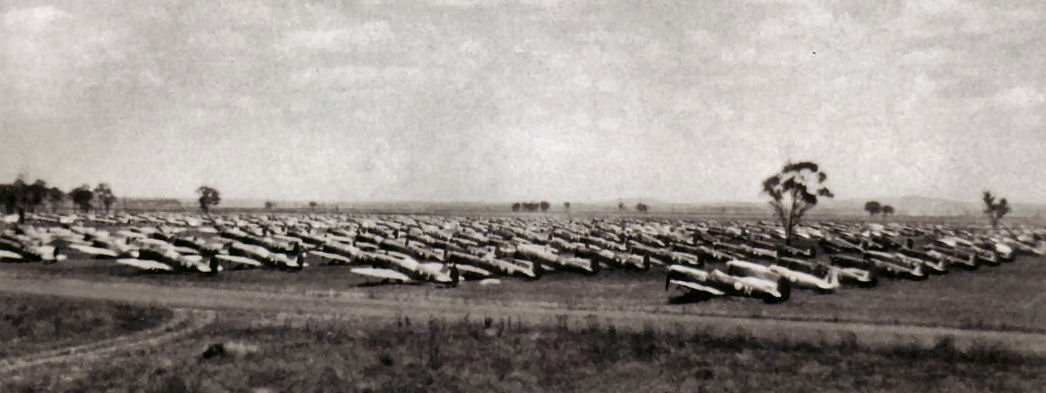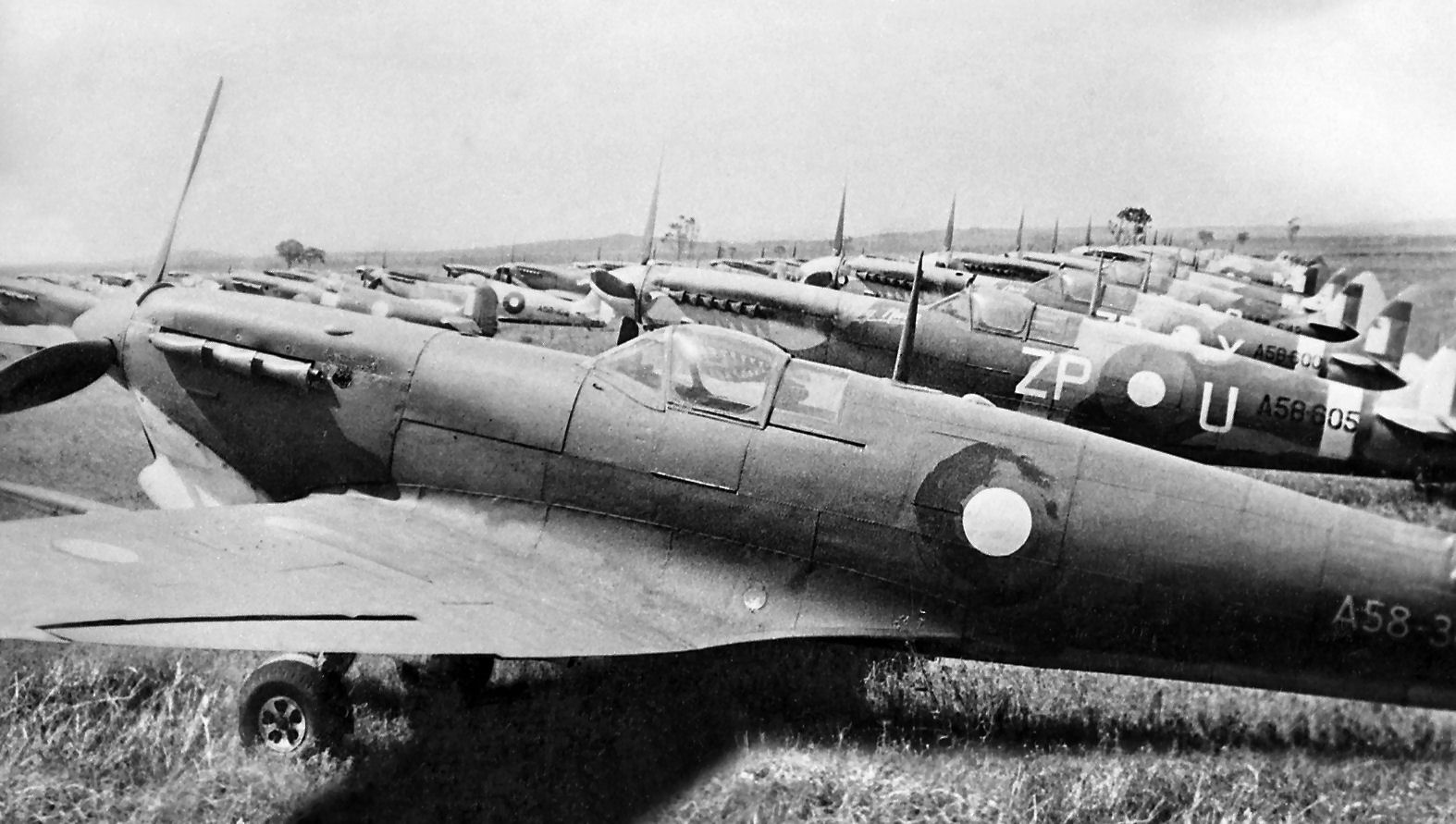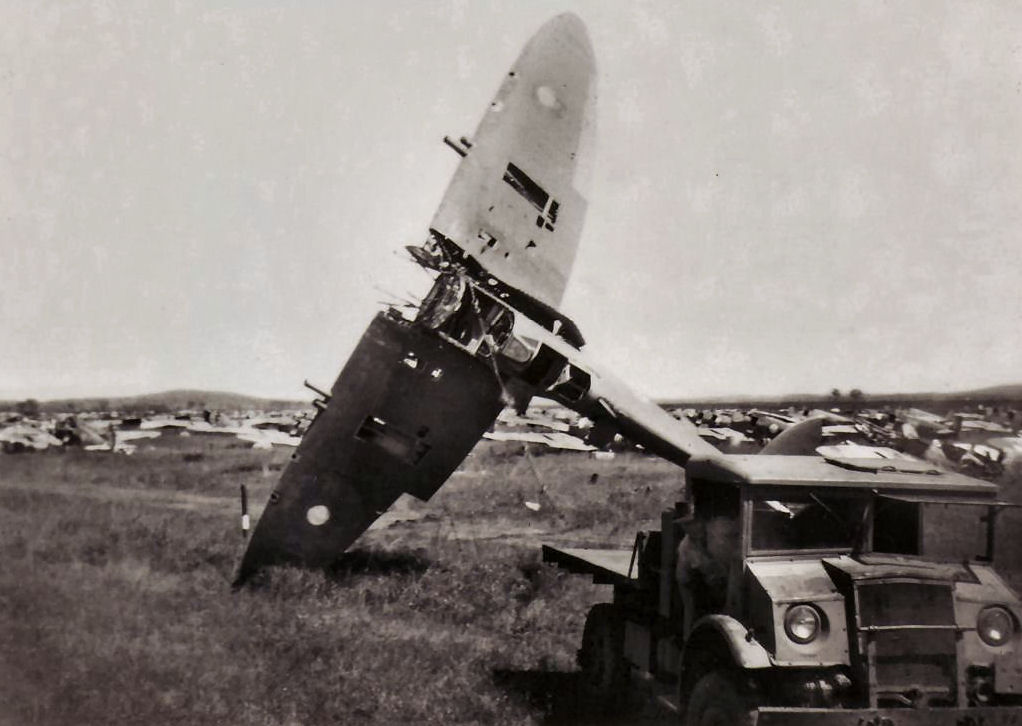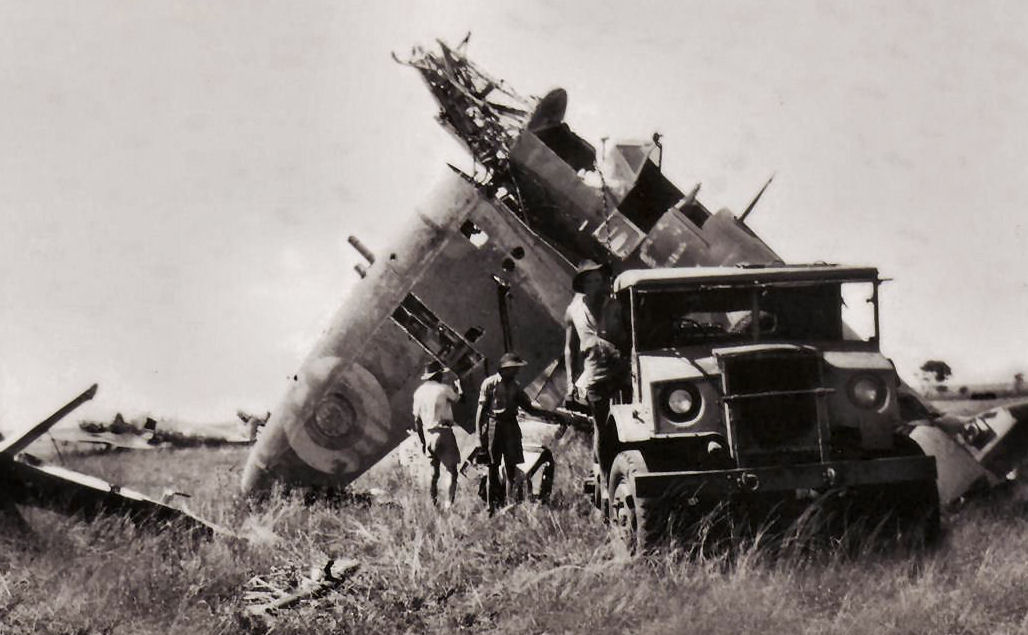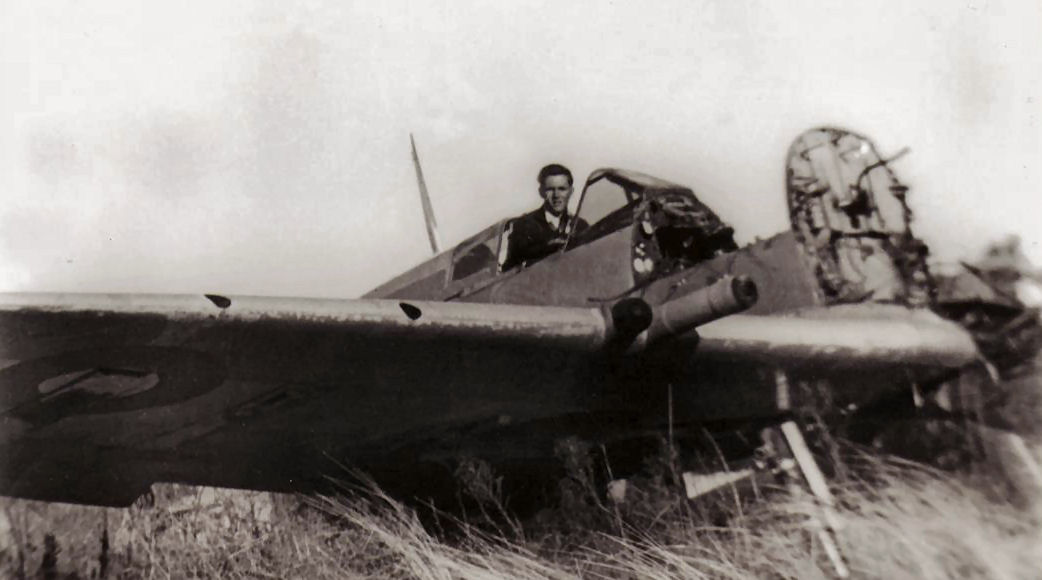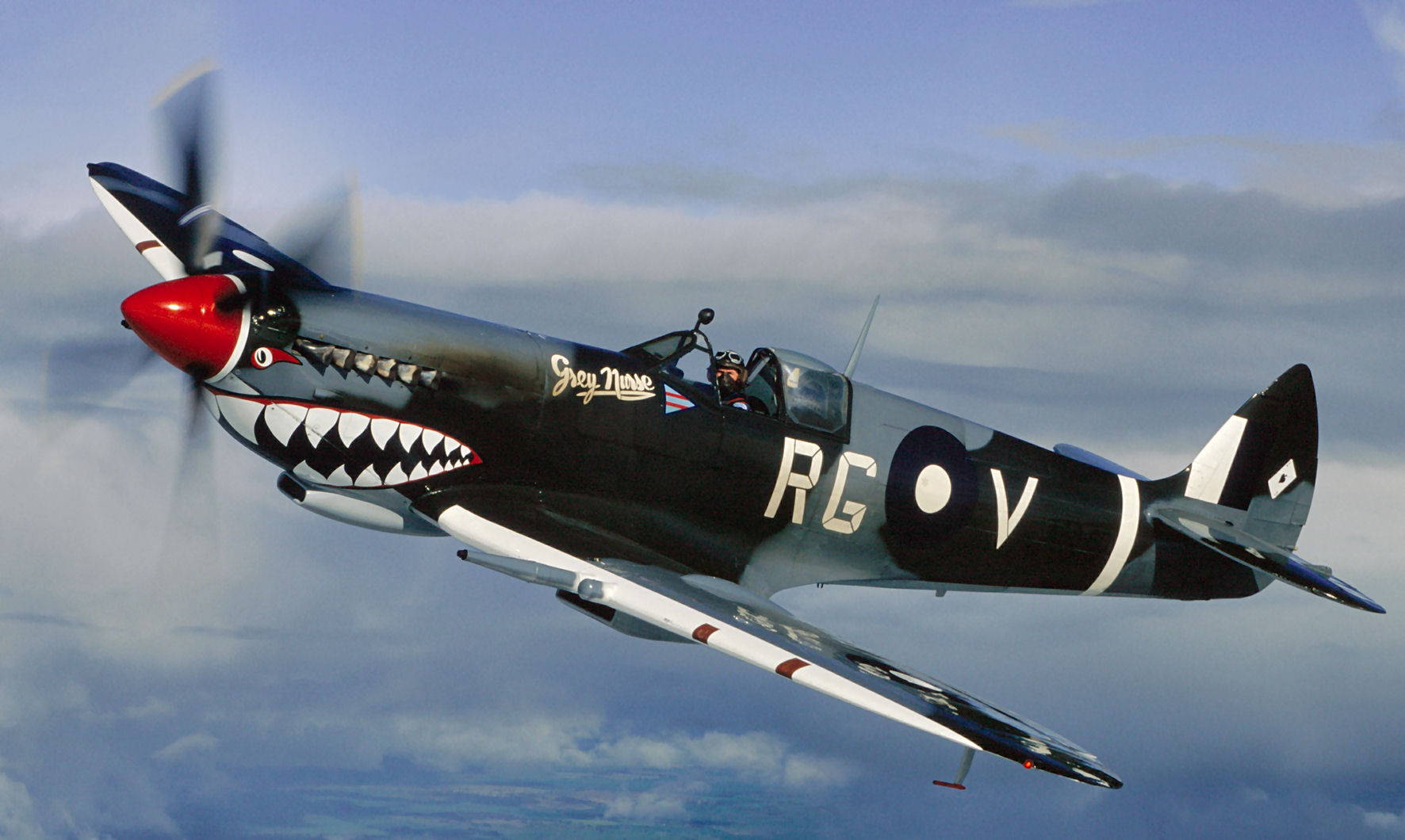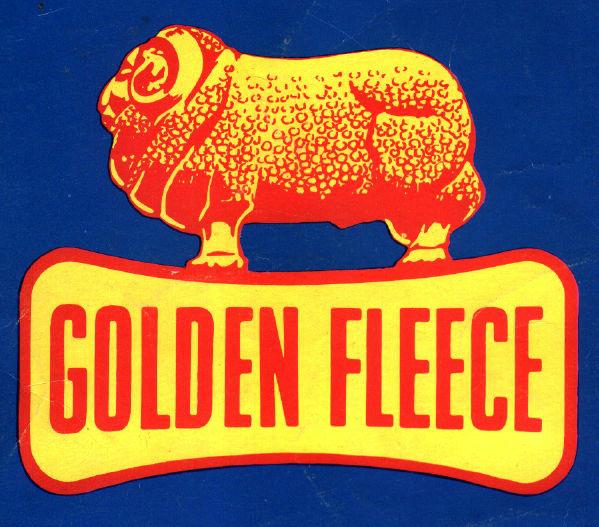|
Radschool Association Magazine - Vol 36 Page 13 |
|
Privacy Policy | Editorial Policy | Join the Association | List of Members | Contact us | Index | Links | Print this page |
|
|
|
Australia’s Lost Spitfires – Fact or Fantasy.
E. A. (Ted) Strugnell
IT'S the Lasseter's Reef of warbirds - a rumoured stash of mint-condition Spitfires hidden underground in rural Queensland. Many have searched for the legendary British fighters, reportedly still in their crates and hidden since the end of the World War II around the Queensland town of Oakey, but so far, nobody has been able to lay claim to what would be a multi-million-dollar find.
|
|
|
|
|
|
They are the remnants of the 656 Mark V and Mark VIII Spitfires that were delivered to the RAAF during the war.
RAAF records show that 544 aircraft, 232 of them Spitfires, were flown to Oakey to be sold to a scrap metal dealer.
That should have been the ignominious end of arguably the greatest single place fighter ever built, certainly the most legendary and romanticised. But was it?
Opinions vary on the mystery and stories range from a high-level defence conspiracy among senior RAAF Officers to a single leading aircraftman who either hid or buried aircraft because he couldn't bear to see the magnificent machines destroyed.
If hidden aircraft do exist, there are three main possibilities. These are they are buried, stored in a hidden underground hangar or secreted in a coal mine.
Not everyone believes they are there.
Toowoomba resident Laurie Wenham, who was employed in breaking down the aircraft prior to melting in 1948, is sceptical there are any aircraft at all.
“I do not believe there are any hidden aircraft and various ‘sightings’ over the years were probably parts or partial aircraft pilfered or purchased as scrap,'' he said.
But a lifetime Oakey resident, who did not wish to be named, claims to be a reliable witness to the burial site of five aircraft in what may have been a trial disposal near the old Federal Mine.
While he did not see aircraft going into the ground he saw contractors digging a trench and saw a large crate in it. The contractors claimed a quarter of a century later to have buried the aircraft but could not be contacted for the purposes of this story.
|
|
|
|
Spitfire Park at Oakey, Circa 1945. |
|
|
|
However, this was enough to prompt Bungunya farmer and pilot David Mulckey to launch an excavation in 2001. This was the best search ever undertaken and included aerial photographic surveys retrieved from the archives for the years before and after the alleged burial that indicated substantial digging.
Late access to the eye witness and misreading of aerial surveys were blamed for the venture's failure.
“As soon as I arrived, I realized that we were in the paddock adjacent to, not on, the correct site,'' said Mr Mulckey, who did not have council approval to investigate the adjoining property. That property still contained evidence of digging and heavy lifting, even after 60 years and his aim is to return to at least eliminate the site as a possibility.
More recently, another ex-WWII airman has since claimed that during an exchange of confidences on an Anzac Day in the 1950's another airman and lifelong friend told him that he and others had hidden aircraft in a hole in the side of a hill near Oakey.
The underground hangar story centres on reports of a squadron of 16-18 Spitfires, supposedly Mk XIVs in creates, hidden in underground storage with spares and fuel for the re-taking of Queensland in the event a Japanese invasions forced a retreat to the infamous Brisbane Line.
The fact that Mk XIVs never saw service with the RAAF is explained by believers of this theory with claims they were especially imported for this purpose.
This version of the story appeared in the Royal Air Force News in the 1980's and UK authorities thought it had sufficient substance to send a RAF Group Captain, Wing Commander and a technical NCO to Oakey to investigate.
A more likely possibility is that the underground hanger theory developed in the telling and retelling of rumours that a few aircraft had been buried, hidden or dumped in a disused coal mine.
|
|
|
|
|
|
There were plenty of opportunities to do this because there were and are numerous abandoned coal mines within minutes of the airfield.
The sheer numbers of aircraft, the persistence of the stories from disparate sources suggest it is likely that some aircraft remain.
Private pilot and vintage aircraft restorer Bill Martin, who has possibly done more research on this subject than anyone alive, believes some aircraft exist in some form somewhere.
Martin has photographs of aircraft in the disposal lines at Oakey circa 1945 that look like Mk XIVs and has spoken to eye witnesses who had seen evidence to indicate Mk XIVs may have been at Oakey, possibly on loan from the RAF for trials.
The RAF had a squadron of Mk XIVs in Australia for the defence of Darwin and it is likely some of them could have been at Oakey for deeper maintenance at war's end.
Other speculation includes the possibility a small number of planes were fitted with classified equipment and were not allowed to be onsold.
A common way of disposing of aircraft was to dump them at sea but what if one of the drivers used his initiative to deposit his loads in a mine to spend a couple of hours in the local pub rather than on round trip to the Brisbane wharves.
Lester Reisinger, who has conducted a number of searches, subscribed to the underground storage theory.
“They're there alright, under the Oakey drive-in theatre,'' he said. An old mine, The Federal, passed under the now-disused drive-in and was the closest to the airfield. It closed in 1943 and two separate sources believed one driver was never away long enough to make the round trip to Brisbane. It would not have been too difficult for one man to transfer a crated spitfire from a truck to an old mine wagon, using the hand-operated gantry for transferring coal from the mine wagons to railway wagons.
|
|
|
|
|
|
Mr Martin and Mr Reisinger several times spoke to a man who swore he had been into an underground storage facility containing wooden crates on rail trolleys.
However, the witness could not tell whether the crates held complete aircraft, parts, or something else.
Both men believe the witness to be reliable but because he was taken to the site at night by another man he was unable to pin-point a location. However, as it was only a short walk from the man's house in Federal Street, near the mine of the same name, it was almost certainly the old Federal Mine possibly accessed from a cave-in, not uncommon at the time.
Mr Martin also had an aerial photograph taken on 30th September 1945 clearly showing the entrance tunnel to the Federal Mine still open with the railway line, rails shiny from possible recent use, going into the tunnel. The mine entrance was collapsed in the 1950s by the Jondaryan Shire Council.
The same aerial photograph also clearly shows large crates sitting beside the nearby airfield. Australian Army Intelligence determined these to be the size of Spitfire crates but they were not there by 1948 in Laurie Wenham’s time. The Spitfire was the only aircraft disposed of at Oakey that was shipped in a single crate. It is unlikely such large crates would be destroyed when there were massive equipment movements.
|
|
|
|
|
|
Ultimately there are several possible motives, official and unofficial, for hiding aircraft. There were almost certainly numerous opportunities to do so.
There are a lot of old stories and rumours, a lot of circumstantial, anecdotal and highly speculative evidence, and a little physical evidence.
|
|
This Spitfire was the last delivered to the RAAF at war’s end and never saw operational service. It is now owned and operated by the Temora Aviation Museum. The aircraft is restored in the green and grey camouflage colours worn by the RAAF “Grey Nurse” 457 Squadron aircraft defending Darwin during World War II and in operations in the South West Pacific. The aircraft carries the personal markings (ace of spades on rudder) of Wing Commander R.H. (Bobby) Gibbes. (Click the pic for a bigger view) |
|
|
|
The only living eye witness located so far is testing a memory over almost sixty years.
If the aircraft exist, sufficient resources and modern technology could locate them relatively cheaply and easily or at least eliminate the most likely place, the old Federal mine.
It is also possible that the aircraft have already been spirited out of Australia. Either way, like Lasseter’s elusive reef of gold, it remains a riddle waiting to be solved. There is further info HERE
Ted Strugnell now lives in Toowoomba, Queensland, and served 31 years in the RAAF and RAAF-AR, in Australia and abroad, and 21 years with the Department of Defence. Anybody who took part in, or who has knowledge of, these or similar events is urged to contact him on eastrug@icr.com.au.
|
|
Psychiatrists vs Bartenders
Ever since I was a child, I’ve had a fear of someone under my bed at night, so I went to a Shrink and told him.
I've got problems, I said, Every time I go to bed I think there's somebody under it. I'm scared. I think I'm going crazy.'' Just put yourself in my hands for one year,' said the shrink. 'Come talk to me three times a week and we should be able to get rid of those fears.. ''How much do you charge?' I asked, 'Eighty dollars per visit,' replied the doctor. 'I'll sleep on it,' I said. Six months later the doctor met me on the street. 'Why didn't you come to see me about those fears you were having?' he asked. 'Well, Eighty dollars a visit three times a week for a year is an awful lot of money! A bartender cured me for $10. I was so happy to have saved all that money that I went and bought a new car! ''Is that so?” he said with a bit of an attitude, 'and how, may I ask, did a bartender cure you?'' “He told me to cut the legs off the bed! - Ain't nobody under there now!!!'
FORGET THE SHRINKS….HAVE A DRINK AND TALK TO A BARTENDER!
|
|
Fred Robinson sent us this video of aircraft being refueled by the Golden Fleece company at East Sale back in 1955. Golden Fleece was owned by HC Sleigh Ltd, a company which was started by Hamilton Sleigh. Sleigh began selling motor spirit back in 1913. In those days, fuel was sold in 4 gallon drums and it wasn’t until 1920 that the first fuel pump was installed by Golden Fleece.
Sleigh pioneered the concept of single brand outlets in times when the norm saw multi-brand service stations throughout Australia. In 1947 H.C.Sleigh Ltd became a public company and in 1981, Caltex acquired all the stock and took it over.
Have a look at the video, you might know someone……See it HERE (This is a very big file and will take a while to load - worth the effort though) |
|
|
|
Back Go to page: 1 2 3 4 5 6 7 8 9 10 11 12 13 14 15 16 17 18 19 20 Forward
|
